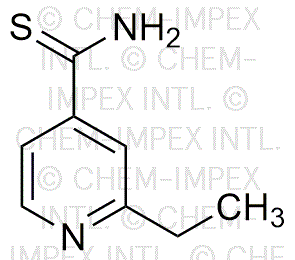Ethionamide is widely utilized in research focused on
- Tuberculosis Treatment: Ethionamide is primarily used as an antibiotic in the treatment of multidrug-resistant tuberculosis, providing an essential option for patients who do not respond to standard therapies.
- Antimicrobial Research: Researchers use ethionamide to study its effects on various bacterial strains, helping to develop new antimicrobial agents and understand resistance mechanisms.
- Pharmaceutical Development: It serves as a key compound in the synthesis of new drugs, particularly in the design of anti-infective agents, due to its unique chemical properties.
- Laboratory Studies: Ethionamide is employed in laboratory settings to investigate its pharmacokinetics and pharmacodynamics, aiding in the optimization of dosing regimens for better patient outcomes.
- Veterinary Medicine: The compound is also explored for its potential applications in veterinary medicine, particularly for treating infections in livestock, thereby improving animal health and productivity.
Informations générales
Propriétés
Sécurité et réglementation
Applications
Ethionamide is widely utilized in research focused on
- Tuberculosis Treatment: Ethionamide is primarily used as an antibiotic in the treatment of multidrug-resistant tuberculosis, providing an essential option for patients who do not respond to standard therapies.
- Antimicrobial Research: Researchers use ethionamide to study its effects on various bacterial strains, helping to develop new antimicrobial agents and understand resistance mechanisms.
- Pharmaceutical Development: It serves as a key compound in the synthesis of new drugs, particularly in the design of anti-infective agents, due to its unique chemical properties.
- Laboratory Studies: Ethionamide is employed in laboratory settings to investigate its pharmacokinetics and pharmacodynamics, aiding in the optimization of dosing regimens for better patient outcomes.
- Veterinary Medicine: The compound is also explored for its potential applications in veterinary medicine, particularly for treating infections in livestock, thereby improving animal health and productivity.
Documents
Fiches de données de sécurité (FDS)
La FDS fournit des informations de sécurité complètes sur la manipulation, le stockage et l’élimination du produit.
Spécifications du produit (PS)
Le PS fournit une description complète des propriétés du produit, notamment sa composition chimique, son état physique, sa pureté et les exigences de stockage. Il détaille également les plages de qualité acceptables et les applications prévues du produit.
Certificats d'analyse (COA)
Recherchez des certificats d'analyse (COA) en saisissant le numéro de lot du produit. Les numéros de lot et de lot se trouvent sur l'étiquette d'un produit, après les mots « Lot » ou « Lot de fabrication ».
Numéro de catalogue
Numéro de lot/série
Certificats d'origine (COO)
Ce certificat d'exploitation confirme le pays dans lequel le produit a été fabriqué, et détaille également les matériaux et composants utilisés et s'il est issu de sources naturelles, synthétiques ou autres sources spécifiques. Ce certificat peut être requis pour les douanes, le commerce et la conformité réglementaire.
Numéro de catalogue
Numéro de lot/série
Fiches de données de sécurité (FDS)
La FDS fournit des informations de sécurité complètes sur la manipulation, le stockage et l’élimination du produit.
DownloadSpécifications du produit (PS)
Le PS fournit une description complète des propriétés du produit, notamment sa composition chimique, son état physique, sa pureté et les exigences de stockage. Il détaille également les plages de qualité acceptables et les applications prévues du produit.
DownloadCertificats d'analyse (COA)
Recherchez des certificats d'analyse (COA) en saisissant le numéro de lot du produit. Les numéros de lot et de lot se trouvent sur l'étiquette d'un produit, après les mots « Lot » ou « Lot de fabrication ».
Numéro de catalogue
Numéro de lot/série
Certificats d'origine (COO)
Ce certificat d'exploitation confirme le pays dans lequel le produit a été fabriqué, et détaille également les matériaux et composants utilisés et s'il est issu de sources naturelles, synthétiques ou autres sources spécifiques. Ce certificat peut être requis pour les douanes, le commerce et la conformité réglementaire.


